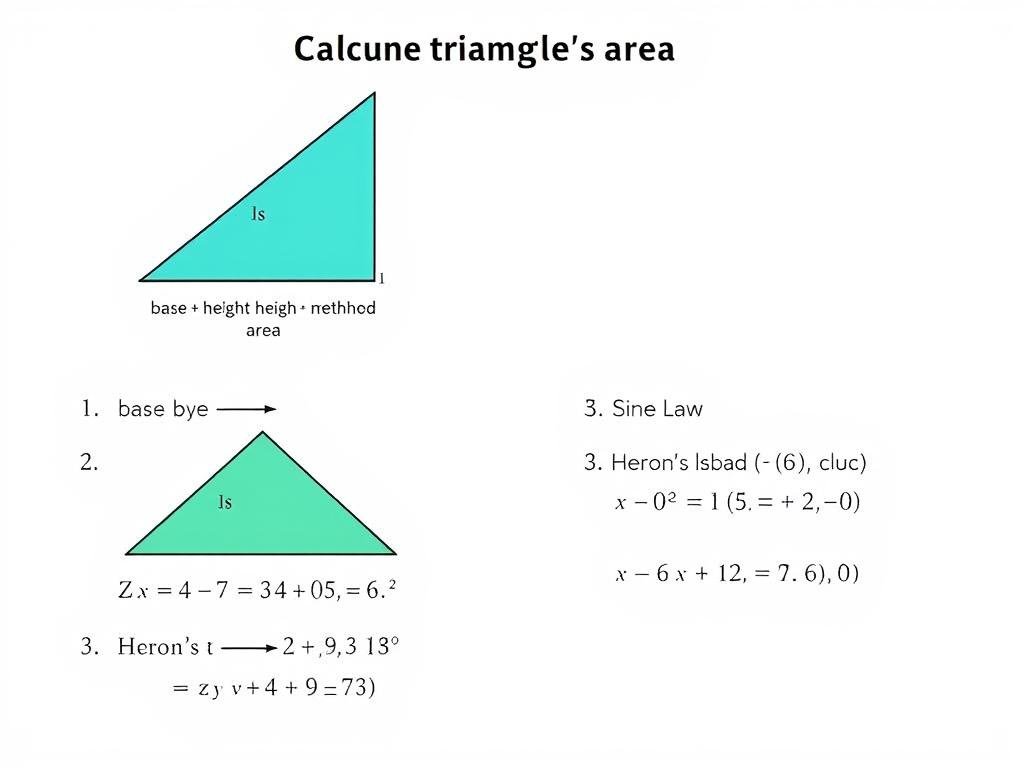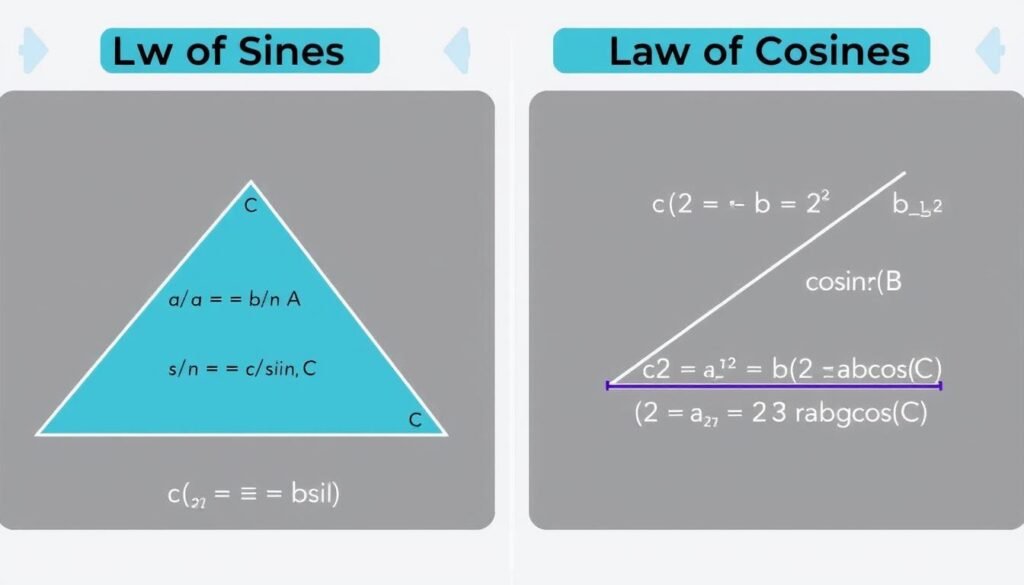Triangle Calculator helps you calculate sides, angles, area, and perimeter of any triangle. Quick, accurate, and perfect for math and geometry problems.
Triangle Calculator
A triangle calculator is a powerful mathematical tool designed to solve various triangle problems with precision and ease. Whether you’re a student tackling geometry homework, an engineer working on structural designs, or a professional needing quick and accurate calculations, our triangle calculator provides comprehensive solutions for all triangle-related calculations. This guide explains everything you need to know about triangles and how our calculator can simplify complex mathematical operations.

What is a Triangle Calculator?
A triangle calculator is a specialized tool that helps determine unknown values of a triangle based on the information you provide. By entering known measurements such as sides, angles, area, or height, the calculator applies geometric principles and trigonometric formulas to compute the missing values. This eliminates the need for manual calculations and reduces the possibility of errors.
Need Quick Triangle Solutions?
Stop struggling with complex formulas and manual calculations. Our triangle calculator provides instant, accurate results for any triangle problem.
The calculator can handle various triangle types and calculation methods, including:
- SSS (Side-Side-Side): When all three sides are known
- SAS (Side-Angle-Side): When two sides and the included angle are known
- ASA (Angle-Side-Angle): When two angles and the included side are known
- AAS (Angle-Angle-Side): When two angles and a non-included side are known
- SSA (Side-Side-Angle): When two sides and a non-included angle are known
Understanding Triangle Properties
Before diving into calculations, it’s essential to understand the fundamental properties of triangles. A triangle is a polygon with three sides, three vertices, and three internal angles that sum to 180 degrees (or π radians).
Basic Triangle Components
Sides: Every triangle has three sides, typically denoted as a, b, and c. The side opposite to angle A is labeled as a, the side opposite to angle B is labeled as b, and the side opposite to angle C is labeled as c.
Angles: The three internal angles of a triangle are usually denoted as A, B, and C (or α, β, and γ). These angles always sum to 180 degrees.

Derived Properties
From these basic components, we can derive several important properties:
- Perimeter: The sum of all three sides (a + b + c)
- Semi-perimeter (s): Half of the perimeter, calculated as s = (a + b + c)/2
- Area: Can be calculated using various formulas depending on the known values
- Heights (Altitudes): The perpendicular distances from each vertex to the opposite side
- Medians: Line segments connecting each vertex to the midpoint of the opposite side
- Angle Bisectors: Lines that divide each angle into two equal parts
Types of Triangles
Triangles can be classified based on their sides or angles. Understanding these classifications helps in applying the appropriate formulas for calculations.

Classification Based on Sides
Equilateral Triangle
All three sides have equal lengths, and all three angles are equal (60 degrees each).
Properties: a = b = c and A = B = C = 60°
Isosceles Triangle
Two sides have equal lengths, and the angles opposite to these sides are also equal.
Properties: If a = b, then A = B
Scalene Triangle
All three sides have different lengths, and all three angles have different measures.
Properties: a ≠ b ≠ c and A ≠ B ≠ C
Classification Based on Angles
Right Triangle
Contains one right angle (90 degrees). The side opposite to the right angle is called the hypotenuse.
Properties: One angle equals 90°
Acute Triangle
All three angles are less than 90 degrees.
Properties: A
Obtuse Triangle
One angle is greater than 90 degrees.
Properties: One angle > 90°
Need to Identify Your Triangle Type?
Our triangle calculator automatically identifies the triangle type based on your input and applies the appropriate formulas.
Essential Triangle Formulas
Depending on the information available, different formulas can be used to calculate triangle properties. Here are some of the most important formulas used in our triangle calculator:
Area Formulas
Basic formula: Area = ½ × base × height
Heron’s formula: Area = √[s(s-a)(s-b)(s-c)], where s is the semi-perimeter
Using two sides and the included angle: Area = ½ × a × b × sin(C)

The Pythagorean Theorem
For right triangles, the Pythagorean theorem states that the square of the length of the hypotenuse equals the sum of the squares of the lengths of the other two sides:
c² = a² + b², where c is the hypotenuse

Law of Sines
The law of sines establishes the relationship between the sides of a triangle and the sines of the opposite angles:
a/sin(A) = b/sin(B) = c/sin(C)
This formula is particularly useful when solving triangles using the ASA, AAS, or SSA methods.
Law of Cosines
The law of cosines relates the lengths of the sides of a triangle to the cosine of one of its angles:
c² = a² + b² – 2ab × cos(C)
a² = b² + c² – 2bc × cos(A)
b² = a² + c² – 2ac × cos(B)
This formula is essential when solving triangles using the SSS or SAS methods.

Step-by-Step Triangle Calculation Examples
Let’s walk through some practical examples of triangle calculations to demonstrate how our triangle calculator works.
Example 1: Solving a Triangle Using SSS Method
Given the three sides of a triangle: a = 7 cm, b = 8 cm, c = 9 cm

- Calculate the semi-perimeter: s = (a + b + c)/2 = (7 + 8 + 9)/2 = 12 cm
- Calculate the area using Heron’s formula: Area = √[s(s-a)(s-b)(s-c)] = √[12(12-7)(12-8)(12-9)] = √[12 × 5 × 4 × 3] = √720 ≈ 26.83 cm²
- Calculate angle A using the law of cosines: A = cos⁻¹[(b² + c² – a²)/(2bc)] = cos⁻¹[(8² + 9² – 7²)/(2 × 8 × 9)] = cos⁻¹[0.6944] ≈ 46.04°
- Calculate angle B using the law of cosines: B = cos⁻¹[(a² + c² – b²)/(2ac)] = cos⁻¹[(7² + 9² – 8²)/(2 × 7 × 9)] = cos⁻¹[0.6349] ≈ 50.48°
- Calculate angle C using the law of cosines: C = cos⁻¹[(a² + b² – c²)/(2ab)] = cos⁻¹[(7² + 8² – 9²)/(2 × 7 × 8)] = cos⁻¹[0.5357] ≈ 57.69°
- Verify that the sum of angles equals 180°: 46.04° + 50.48° + 57.69° ≈ 154.21° (slight difference due to rounding)
Example 2: Solving a Right Triangle
Given a right triangle with one leg a = 5 cm and hypotenuse c = 13 cm

- Calculate the other leg using the Pythagorean theorem: b² = c² – a² = 13² – 5² = 169 – 25 = 144, so b = 12 cm
- Calculate angle A: A = sin⁻¹(a/c) = sin⁻¹(5/13) ≈ 22.62°
- Calculate angle B: B = 90° – A = 90° – 22.62° = 67.38°
- Calculate the area: Area = (a × b)/2 = (5 × 12)/2 = 30 cm²
- Calculate the perimeter: Perimeter = a + b + c = 5 + 12 + 13 = 30 cm
Skip the Manual Calculations
Our triangle calculator performs all these steps automatically, saving you time and ensuring accuracy.
Practical Applications of Triangle Calculations
Triangle calculations have numerous practical applications across various fields. Here are some real-world scenarios where our triangle calculator can be invaluable:
Architecture and Construction
Architects and construction professionals use triangle calculations for:
- Designing roof trusses and determining pitch angles
- Calculating material requirements for triangular structures
- Ensuring structural stability through triangulation
Engineering and Physics
Engineers and physicists apply triangle principles for:
- Vector analysis and force calculations
- Surveying and land measurement
- Optical systems and light refraction
Navigation and Geography
Navigators and geographers use triangles for:
- Triangulation to determine positions and distances
- Calculating areas of irregular land parcels
- Creating topographic maps and measuring elevations

Educational Applications
In educational settings, our triangle calculator serves as:
- A learning tool for students to verify their manual calculations
- A way to visualize abstract geometric concepts
- A time-saving resource for homework and exam preparation
- A method to explore the relationships between different triangle properties
Advanced Triangle Concepts
Beyond the basic properties, there are several advanced concepts related to triangles that our calculator can help you explore:
Triangle Centers
A triangle has several important centers:
- Centroid: The point where the three medians intersect
- Orthocenter: The point where the three altitudes intersect
- Circumcenter: The center of the circle that passes through all three vertices
- Incenter: The center of the circle that is tangent to all three sides

Circle Properties Related to Triangles
Two important circles associated with triangles are:
- Circumscribed Circle (Circumcircle): The circle that passes through all three vertices of the triangle. Its radius (R) can be calculated using the formula: R = (abc)/(4 × Area)
- Inscribed Circle (Incircle): The circle that is tangent to all three sides of the triangle. Its radius (r) can be calculated using the formula: r = Area/s, where s is the semi-perimeter

Why Use Our Triangle Calculator?
Our triangle calculator offers numerous benefits that make it an essential tool for anyone working with triangles:
- Saves time by automating complex calculations
- Eliminates human error in mathematical operations
- Handles all triangle types and calculation methods
- Provides comprehensive results including sides, angles, area, perimeter, and more
- Offers step-by-step solutions for educational purposes
- Accessible anytime, anywhere with an internet connection
Benefits of Our Triangle Calculator
Whether you’re a student learning geometry, a teacher creating educational materials, or a professional needing quick and accurate triangle calculations, our triangle calculator is designed to meet your needs with precision and ease of use.
Ready to Solve Your Triangle Problems?
Try our comprehensive triangle calculator now and experience the convenience of instant, accurate triangle calculations.